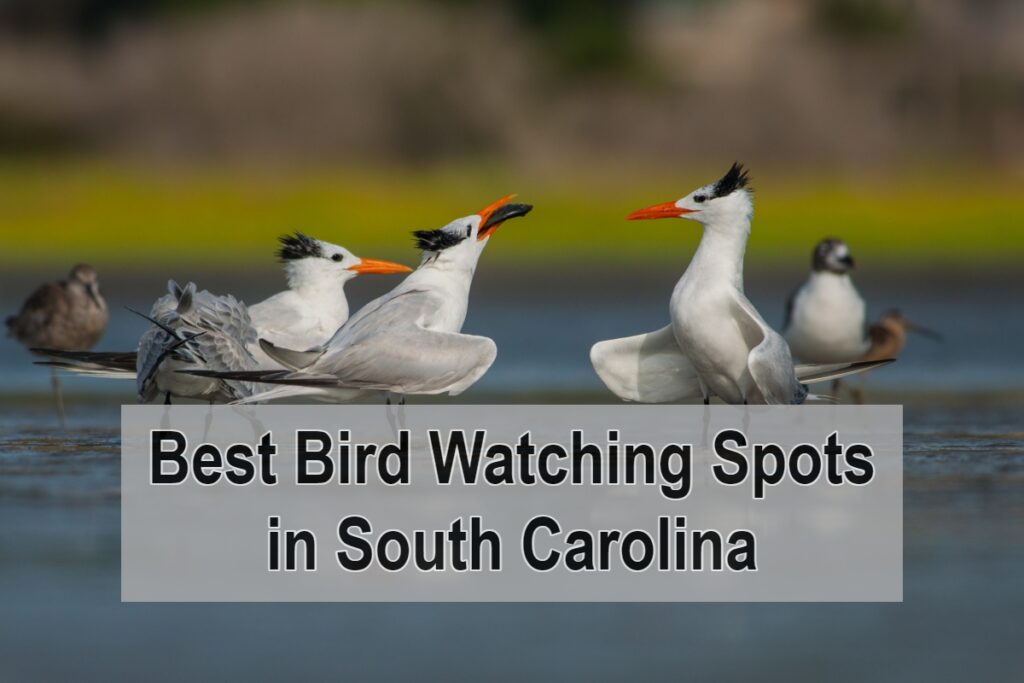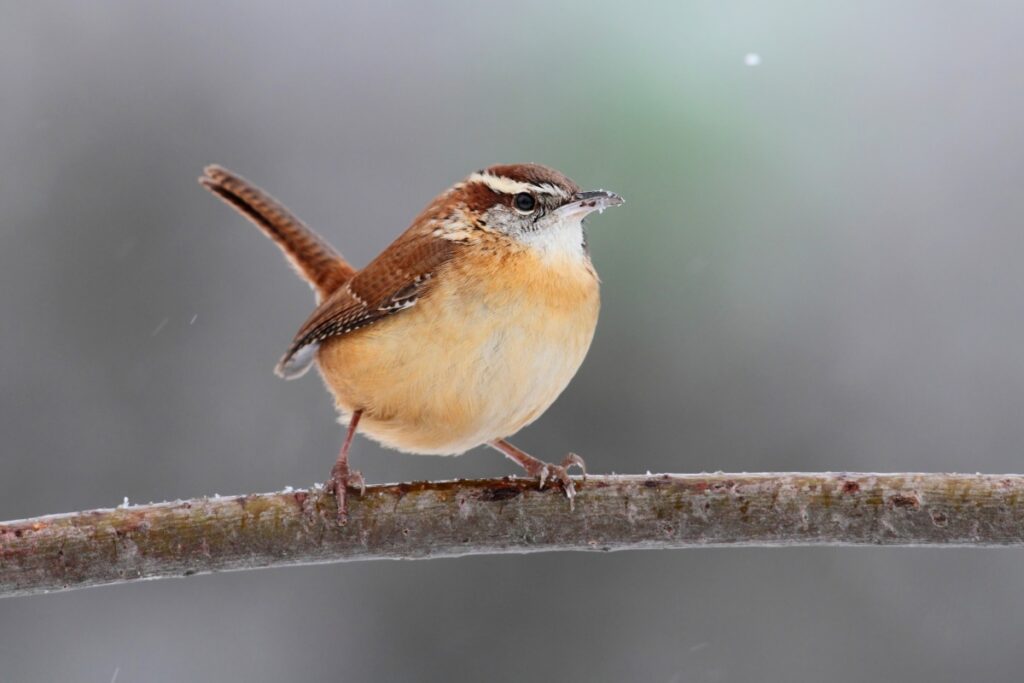As an Amazon Associate, we earn from qualifying purchases with no additional costs for you.
South Carolina is south of North Carolina and has a coastline with the Atlantic Ocean. The state has a record of 424 bird species, but knowing where to bird watch here can be tricky, so I wrote this article about the best spots to visit for bird watching.
The best bird watching spots in South Carolina are those with various habitats, like Huntington Beach and Francis Marion National Forest. Other good birding spots are those along the Atlantic Coast, like Lighthouse Inlet, and those with many wetlands, such as Bear Island Wildlife Management Area.
A table giving the most exciting birds you can see at each of my top 10 birding spots in South Carolina:
| PARK | INTERESTING BIRDS YOU CAN SEE |
|---|---|
| Huntington Beach State Park | Bald Eagle and Red-throated Loon |
| Bear Island Wildlife Management Area | Swallow-tailed Kite and Seaside Sparrow |
| Congaree National Park | Mississippi Kite and Kentucky Warbler |
| Carolina Sandhills National Wildlife Refuge | Red-cockaded Woodpecker and Bachman’s Sparrow |
| Lighthouse Inlet Heritage Preserve | Purple Sandpiper and Red-throated Loon |
| Francis Marion National Forest | Screech Owl and Eastern Whip-poor-will |
| Savannah National Wildlife Refuge | Roseate Spoonbill and Anhinga |
| Caesars Head State Park | Ruffed Grouse and Common Raven |
| Santee National Wildlife Refuge | Sandhill Crane and Osprey |
| Francis Beidler Forest Audubon Center and Sanctuary | Barred Owl and Northern Parula |
Read further to learn more details on the bird watching spots found in South Carolina and which birds may be found in these places.
TIP: If you want to check out the best pair of binoculars for bird watching, we recommend a pair of waterproof and fog-proof 8 x 42 binoculars like the Celestron – Outland X 8×42 Binoculars (Amazon link).
Best Places to Bird Watch in South Carolina
Several excellent birding places in South Carolina provide good birding opportunities.
1. Huntington Beach State Park
This park has at least 300 species of birds recorded. It is located on the Atlantic coast and provides a range of habitats, including sandy beaches, a freshwater lagoon, and marshy areas. There are trails and a boardwalk that bird watchers can use.
Bald Eagles breed in the park, and you can find various other species, such as:
- Red-throated Loons,
- Common Loons,
- King Rails,
- Clapper Rails,
- Wood Storks,
- and Least Bitterns.
Roseate Spoonbills, Black-necked Stilts, and Black Skimmers have also been recorded at Huntington Beach State Park. You can find bird species like the Razorbill and Harlequin Duck in winter.
2. Bear Island Wildlife Management Area
The wetland areas here attract large numbers of waterfowl and other birds. There are roads and platforms that you can use for bird watching at Bear Island Wildlife Management Area.
Species that breed in the area include:
- Mottled Duck,
- Swallow-tailed Kite,
- Mississippi Kite,
- Black Rail,
- Seaside Sparrow,
- and Painted Bunting.
Clapper Rails and King Rails also nest in the area.
Other waterfowl species here besides Mottled Duck include:
- American Wigeon,
- Ruddy Duck,
- Canvasback,
- Green-winged Teal,
- Redhead,
- Northern Shoveler,
- and Bufflehead.
Least Sandpipers, Short-billed Dowitchers, Greater Yellowlegs, Lesser Yellowlegs, and Long-billed Dowitchers are some of the shorebirds you can find where water is shallow in the refuge.
Marshy areas are where you can find the rails and bitterns. American Bitterns, Least Bitterns, Virginia Rails, and Clapper and King Rails are found in the refuge in the marsh vegetation.
3. Congaree National Park
This park has a large area of old-growth floodplain forest and many trails that bird watchers use to explore and look for birds. There is also a 2.4-mile boardwalk that passes through a bald cypress swamp and bottomland forest.
The visitor center in the park is a good first stop to get a map of the area. Several types of birds can be seen in the park, including waterfowl, waders, passerines, and raptors.
Waders to look out for in the refuge include White Ibis, Anhinga, and Great Egret. You can likely see Yellow-billed Cuckoos in summer and several woodpeckers such as the Red-headed Woodpecker and Pileated Woodpecker.
The pines are an excellent place to see Brown-headed Nuthatches. Hooded Warblers, Yellow-throated Warblers, and Kentucky Warblers have been sighted in the refuge. The Kentucky Warblers are most often seen on the ground in the forest’s understory.
You should look for the Northern Parula and Louisiana Waterthrush near the water. Barred Owls, Mississippi Kites, and Red-shouldered Hawks have all been observed in the refuge.
4. Carolina Sandhills National Wildlife Refuge
This refuge in Chesterfield County is 47,850 acres and includes a vast expanse of longleaf pine. This refuge is crucial for providing suitable habitat for the endangered Red-cockaded Woodpecker.
Other species in these pine forests include the Bachman’s Sparrow and Brown-headed Nuthatch. Several birds breed in the refuge, including:
- Mississippi Kite,
- Baltimore Oriole,
- Orchard Oriole,
- Yellow-billed Cuckoo,
- and Northern Bobwhite.
The Chuck-will’s-widow is also a resident species that nests here but may be difficult to see since the bird is nocturnal. Both Bald Eagles and Osprey have been sighted in the refuge.
It is almost certain you will find warblers in the refuge. Warblers such as Black-throated Green Warblers, Pine Warblers, Swainson’s Warblers, Hooded Warblers, and Prairie Warblers have been observed. People have recorded 21 different warbler species here.
You can see other birds like:
- Eastern Meadowlark,
- Red-winged Blackbird,
- Blue-headed Vireo,
- and Eastern Towhee.
You can use the ebird checklist for details on all the birds recorded in the refuge so far.
TIP: Knowing how to spot the birds in your yard is key to enjoying visits from your winged friends as much as possible! The best sources are trusted books, I recommend using the following (Amazon links):
– National Geographic Field Guide to the Birds of North America
– National Audubon Society Birds of North America
5. Lighthouse Inlet Heritage Preserve
The Lighthouse Inlet Heritage Preserve is on the northern end of Folly Island. It is a good choice for birding because it is located on the edge of the Atlantic Ocean, and you have marsh inland.
In winter, oceanic birds to watch for include Skuas, Jaegers, Black Scoters, Red-throated Loons, and Northern Gannets. You can also see Purple Sandpipers in rocky areas on the shore. The preserve attracts a variety of shorebirds.
Shorebird species include:
- Solitary Sandpipers,
- Greater Yellowlegs,
- Spotted Sandpipers,
- American Avocets,
- American Oystercatchers,
- Black-necked Stilts,
- and Red-necked Phalaropes.
Raptors to look out for in the area include Merlins, Peregrine Falcons, and American Kestrels. Several songbirds have been recorded in the area, including vireos, orioles, and warblers.
Some songbird species found here include:
- Blackpoll Warbler,
- Baltimore Oriole,
- Orchard Oriole,
- Palm Warbler,
- Summer Tanager,
- and Rose-breasted Grosbeak.
There is a printable checklist of the bird species that can be found in the area, which you can use for your visit here.
6. Francis Marion National Forest
The Francis Marion National Forest is a 250,000-acre area of savanna, longleaf pine trees, floodplain forests, marshes, and bald cypress swamps. This vast area has hiking trails, picnic areas, and camping spots, which bird watchers can take advantage of.
Wading birds can be found in the swamp and marsh areas. Such species include:
- Great Blue Heron,
- Great Egret,
- Green Heron,
- and Yellow-crowned Night Heron.
Several bird species live in the forest, including:
- Wood Thrushes,
- Common Nighthawks,
- Acadian Flycatchers,
- Blue-headed Vireos,
- Gray Catbirds,
- Northern Parulas,
- and Black-throated Green Warblers.
The area is also important in providing a habitat for the Red-cockaded Woodpecker, Swallow-tailed Kite, and Mississippi Kite. Three species of owl and other nocturnal species, such as the Eastern Whip-poor-will and Chuck-will’s Widow, can be found in the forest.
Several species of sparrows are found in the area, including:
- LeConte’s Sparrows,
- Chipping Sparrows,
- and Nelson’s Sparrows.
It is also a good idea to visit the South Tibwin Hiking Trail, north of the Sewee Visitor Center. This area is known for birds like:
- Clapper Rail,
- Osprey,
- Painted Bunting,
- and Wood Stork.
TOP TIP: All bird watchers are different. To find out what makes you special as a bird watcher, check out this article, and to find out how birders are not weird, take a look at this one.
7. Savannah National Wildlife Refuge
This refuge is 29,175 acres and has habitats like hardwood forests, wetlands, freshwater marshes, freshwater impoundments, and a tidal river. You can take a four-mile driving route, and you can also walk along the dikes of the ponds.
Some species in the ponds include Black-bellied Whistling Ducks, Hooded Mergansers, and Brown Pelicans. Anhingas and Double-crested Cormorants are also found in the wetlands.
There are many wading birds present in the refuge. Such birds include the Roseate Spoonbills, Great Egrets, and Snowy Egrets.
Besides waders, you can find shorebirds like the Piping Plover and passerines like:
- American Redstarts,
- Great Crested Flycatchers,
- Northern Mockingbirds,
- Red-eyed Vireos,
- and Yellow Warblers.
Marsh-loving birds like the Clapper Rail and King Rail can be seen in the area. Bald Eagles and Mississippi Kites have nested in the refuge.
8. Caesars Head State Park
This park includes a rocky outcropping known as Caesars Head. This is situated on the Blue Ridge Escarpment. This state park also includes a dense forest, a waterfall, and a creek. There are trails you can take and places you can camp.
Birds that breed in the park include species like the Common Raven and Ruffed Grouse. Broad-winged Hawks can also be seen in this area.
Other birds you can find in Caesars Head State Park include the following species:
- Worm-eating Warbler,
- Scarlet Tanager,
- American Redstart,
- Ovenbird,
- and Black-throated Green Warbler.
9. Santee National Wildlife Refuge
This refuge is 13,000 acres and is on the northern side of Lake Marion. At least 296 species of birds have been recorded in this refuge, making it a must-see birding spot.
You should go to the visitor center in the Bluff Unit to get more information about the refuge. In the Bluff Unit, you can walk on a trail that leads to an observation tower.
The Cuddo Unit and Pine Island Unit are two other parts of the refuge. The Cuddo Unit has a route you can drive, while the Pine Island Unit only has walking trails. You can bird in the area at different times to see a range of species.
Wood Storks and Osprey are present in the refuge. In winter, you will see the most waterfowl species, like Mottled Ducks, Northern Pintails, Common Goldeneye, and Bufflehead. Sandhill Cranes can be seen at the Bluff Unit, and Bald Eagle nests occur around the lake in winter.
You can find King Rails and Common Gallinules in the marshy areas and wetlands. Wading birds like Yellow-crowned Night Herons and White Ibises have been observed in the refuge.
Several species of warbler have been seen in the area. Examples of warblers seen here include:
- Yellow-throated Warblers,
- Pine Warblers,
- and Hooded Warblers.
TIP: Check out my recommended products if you are looking for the best and trusted equipment for birdwatching in the wild or on your backyard (Amazon link):
- Celestron Outland X 8×42 Binoculars
- Celestron Ultima 80 Angled Spotting Scope
- National Audubon Society Birds of North America Book
- Design Free-standing Bird Bath
- Smart Bird Feeder with Camera
- Cedar Bird House for Outside
10. Francis Beidler Forest Audubon Center and Sanctuary
This is a 17,000-acre area that consists of bald cypress and tupelo swamp forest. You can take a boardwalk trail to easily access the swamp forest for birding purposes.
Some birds in the area include:
- Barred Owls,
- Prothonotary Warblers,
- Northern Parulas,
- and Yellow-crowned Night Herons.
The refuge can also include:
- Mississippi Kites,
- Red-shouldered Hawks,
- Swainson’s Warblers,
- and Pileated Woodpeckers.
Best Time to Bird Watch in South Carolina
South Carolina is a reliable birding spot, with species found year-round. However, some times of the year are better for seeing particular types of birds.
| TYPES OF BIRDS | SEASON |
|---|---|
| Swallow-tailed Kite | Spring |
| Jaegers and Scoters | Winter |
The South Carolina State Bird
The South Carolina State Bird is the Carolina Wren, Thryothorus ludovicianus. The Carolina Wren is a small bird that is very vocal and has a distinctive and easily recognizable song.
These birds are brown and have a white stripe above the eye. They are insect-eaters with sharp beaks. The tail is often held upwards.
The birds have a distinctive call. They nest in cavities in trees and sometimes nest in unusual places like an old shoe or in somebody’s barn.
Bird Watching Laws in South Carolina
Migratory birds are protected by federal law, and you also are not allowed to hunt migratory game birds without a special permit.
My Favourite Equipment for Bird Watching
Bird watching is one of the least expensive hobbies out there, but you still need some equipment to get the most out of it.
The essential equipment to start bird watching is a pair of binoculars. My preference is 8 X 42 binoculars. The number 8 is how much the magnification is, while 42 is the field of view in millimeters of the lenses.
A pair of waterproof and fog-proof 8 x 42 binoculars like the Celestron – Outland X 8×42 Binoculars on Amazon is an excellent choice for both beginners and experts.
In time, you can choose more expensive models and also opt to buy a spotting scope like the Celestron Ultima 80 on Amazon.
These are a lot more expensive compared with binoculars though, so if you are only a beginner, start with binoculars first. A spotting scope is only helpful for birds far away, such as out on a pond or seashore.
There are a few rules or guidelines you should abide by as an ethical birder. These are listed below.
- Do not enter private lands without prior permission from landowners.
- Follow all the rules in refuges and reserves, including cleaning up any garbage from your campsite.
- Do not disturb birds on nests.
- Do not use apps and play songs to call up birds when they are hungry, tired, and breeding during spring and summer.
Conclusion
South Carolina is a terrific place for bird watching because it has swampland, marshes, pine forests, swamp forests, and a coastline with the Atlantic Ocean.
You can see a good diversity of birds by visiting the listed spots. There is a good chance of adding to your birding life list by visiting this state for birding.
TIP: If you want to check out the best pair of binoculars for bird watching, we recommend a pair of waterproof and fog-proof 8 x 42 binoculars like the Celestron – Outland X 8×42 Binoculars (Amazon link).


